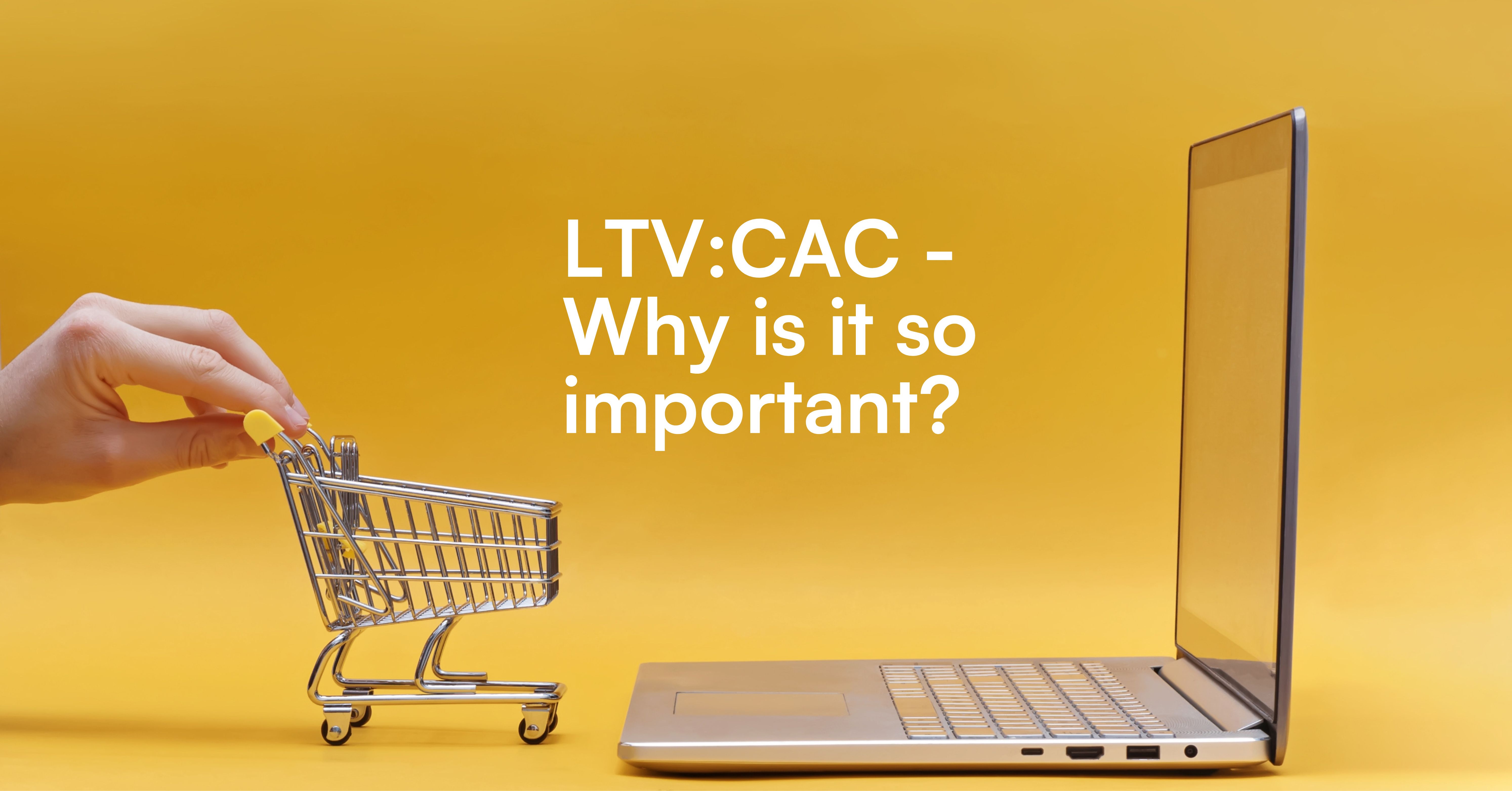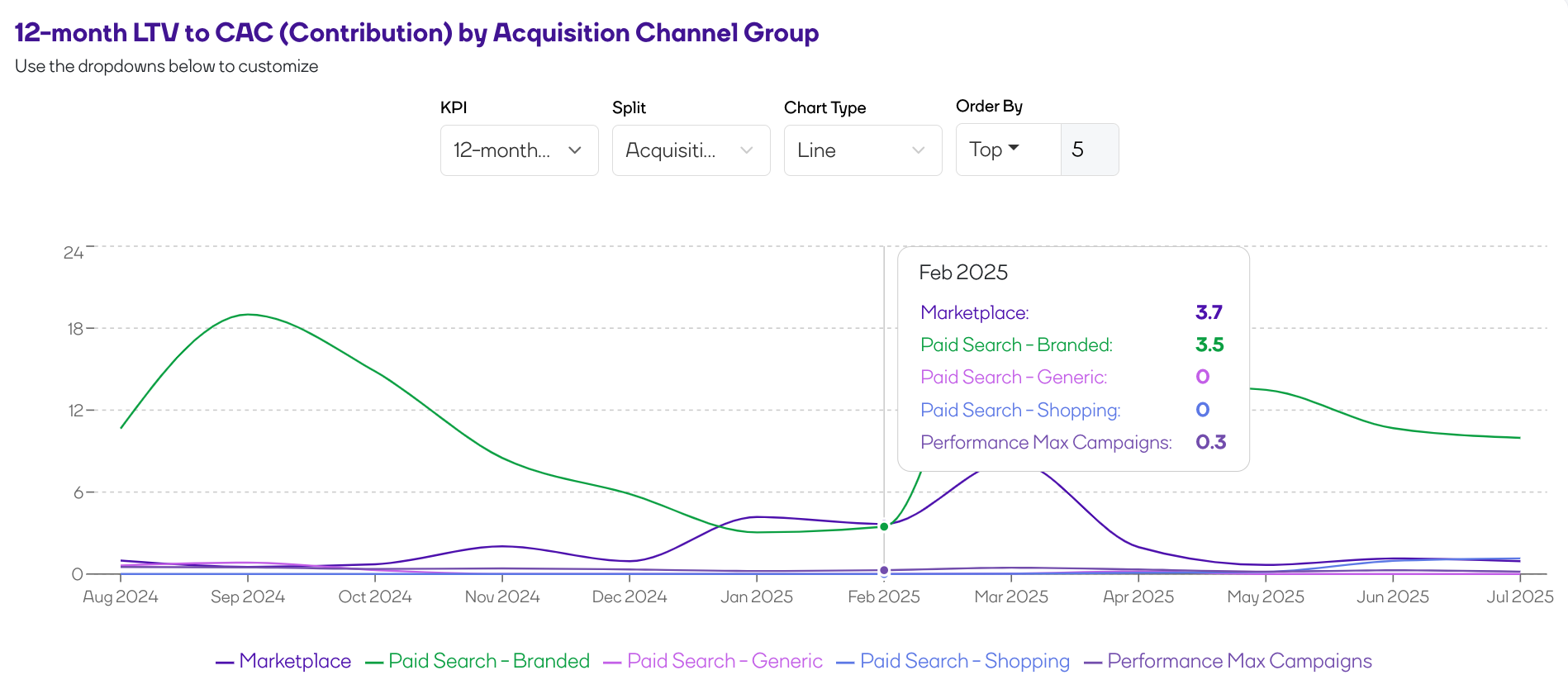December 1, 2025
5 Best Inventory Forecasting Software for eCommerce Brands
Getting your inventory forecasting spot on is an absolute non-negotiable for profitable growth. Here are our top 5 best inventory forecasting software for eCommerce brands.
eCommerce
Thursday, July 17, 2025
LTV CAC is one of the most important eCommerce metrics out there, but not many brands actually track it. Here's how to calculate LTV:CAC, why it's important and how Conjura can help.

eCommerce data is everywhere, and so are those important metrics. From ROAS and AOV to contribution margin and sell-through rates, it can feel like you’re swimming in acronyms. But if there’s one ratio worth surfacing above the rest, it’s LTV:CAC.
Why? Because it tells you something fundamental: whether your customer acquisition strategy is actually sustainable. The LTV:CAC ratio compares the value you get from a customer (their Lifetime Value) to what it costs to acquire them (Customer Acquisition Cost). It’s the fastest way to see if your marketing spend is fuelling profitable growth or just burning budget.
In this post, we’ll break down exactly what LTV:CAC is, how to calculate it, and why it’s a hero metric for smart, data-driven eCommerce businesses. Ready to make your data work harder? Let’s go!
At its simplest, the LTV:CAC ratio measures how much long-term revenue a customer brings in compared to how much it cost to acquire them.
Let’s break that down:
So when you calculate LTV:CAC, you're answering one critical question: Was this customer worth it?
Say your CAC is $100, and your LTV is $500. That gives you a 5:1 ratio, which means for every $1 you spend, you earn $5 back. That’s healthy, profitable growth. But if your ratio is closer to 1:1, you’re barely breaking even. And if it drops below 1? You’re paying more to acquire customers than they’re bringing in.
This ratio cuts through the noise and gives you a clear view of whether your acquisition strategy is fuelling sustainable growth or just draining your budget.

There's no denying that, as a business, you always want to focus on narrowing down relevant metrics. Those will give you insights into profitability, and they make it easier to understand how good of a customer someone truly is. If a customer is not profitable, then it doesn't make sense to invest more into that relationship, or you can start adding discounts and ways to increase the profit ratio. Plus, there are other benefits you get from the LTV:CAC ratio, such as:
Before you can calculate your LTV:CAC ratio, you need to know your numbers. Specifically: how much a customer is worth over time (LTV), and how much it costs to acquire them (CAC). Once you’ve got those, the ratio is easy:
LTV ÷ CAC = your LTV:CAC ratio.
Here’s how to break it down:
LTV tells you how much revenue you can expect from a customer over their time with your brand. The basic formula looks like this:
LTV = Average Order Value × Purchase Frequency × Customer Lifespan – Returns & Refunds
With Conjura, you don’t have to guesstimate these figures. We pull real-time data across your store, ad platforms and customer history to give you an accurate view of what your customers are really worth, no spreadsheets required.
CAC shows how much it costs to acquire a new customer, on average. Use this formula:
CAC = Total Marketing & Sales Spend ÷ Number of New Customers Acquired
Make sure you include all acquisition-related costs: ad spend, agency fees, influencer partnerships, even one-off promos. And remember, we’re only counting new customers here, not repeat ones. When you calculate CAC correctly, you get a clear picture of how efficient your acquisition efforts really are. And when paired with LTV, you’ll know if your marketing spend is fuelling profit or just chasing vanity metrics.
AOV and ROAS are surface metrics, which can prove to be quite handy at times. But as we said, they are surface-level metrics, so you're not getting all the info you would need. For example, ROAS only measures immediate returns. It doesn't take into account repeat purchases, ongoing subscriptions, customer loyalty, and so on. Even if the ROAS is high, it can be misleading when the profit margins are low.
A similar thing is valid when it comes to AOV. When it comes to this metric, you will know how much a customer spends per order. But it doesn't show how many times that customer will make a purchase, and it ignores the CAC. Plus, you can't predict any profitability or long-term benefits that come from a customer, which can prove to be very challenging.
Once you know how to calculate CAC and LTV, you will see why the LTV CAC ratio is very important. You have a good insight into the overtime profitability, and that does matter quite a bit. In addition, this ratio helps you find better strategies that focus on growth. On top of that, you are forced into getting a more holistic view of the funnel. And yes, investors tend to prioritize the LTV/CAC ratio because it's effective and it can provide quantifiable results. You know whether a customer is profitable or not, and the strategies that ensue can be a whole lot better in the long term.
A lot of people are wondering what is a good LTV to CAC ratio. The truth is, these ratios can vary quite a bit, and it always depends on a multitude of factors. But realistically, you always have certain numbers to strive towards, and that is surely a thing that you need to consider. In this case, we made a list with the most common values to consider:
Measuring the LTV to CAC ratio is usually very straightforward. As you saw, learning how to calculate CAC and LTV is simple, and then the ratio just requires you to compare the two and see if you overspend. However, there are certain mistakes that companies make when it comes to measuring the CAC and LTV. It might not seem like a lot, but even the smallest mistakes can prove to be problematic.
Tracking your LTV:CAC is a roadmap for action. While it shows how your business is performing, its real power lies in helping you decide what to do next. With the right insights, you can identify which acquisition channels are worth the investment and which ones are just burning budget. For example, cutting high-CAC channels with low LTV can instantly improve your profitability. On the flip side, you can grow LTV by optimising customer onboarding, offering smarter product bundles, or enhancing your retention strategy. Even if acquiring customers is expensive, increasing their long-term value keeps your ratio healthy. It's also worth refining your audience targeting: doubling down on segments with strong LTV:CAC returns can transform performance. And don't overlook the impact of subscriptions and loyalty programmes, when done right, they can raise LTV significantly. If your ratio starts to dip, it’s a signal to act fast. Making smart, data-driven decisions early helps avoid bigger issues down the line and that’s where the true ROI of LTV:CAC analysis kicks in.
LTV:CAC is only as good as the data behind it and that’s where Conjura shines. Our platform doesn’t just calculate the ratio for you. It makes it meaningful, granular, and ready to act on. Here’s how we do it:
We connect the dots across all your platforms - Shopify, Amazon, Google Ads, Meta, TikTok, and more - so your LTV and CAC figures aren’t siloed by channel. You get one unified view of customer acquisition and value, wherever it happens.
Wondering how your LTV:CAC stacks up? Conjura gives you context with peer benchmarks and proactive alerts, so you can spot outliers and opportunities as they emerge.
Want to know which campaigns or products drive the most valuable customers? We attribute LTV and CAC down to the product and channel level, so you can double down on what’s working and cut what’s not.
Explore performance by acquisition month, discount offer, campaign type - you name it. Conjura’s cohort tools make it easy to understand how different customer segments behave over time.
See lifetime value at the level that matters to you, by SKU, customer segment, or individual customer. Get the precision you need to drive smart acquisition and retention strategies.
No more waiting for end-of-month reports. Track CAC across all your marketing channels in real time, with all costs, including agency fees and offline spend, in one place.
Learning the LTV/CAC ratio is crucial if you want to grow your business. That's why it's important to have the right tools, which can help you figure out how to calculate LTV and CAC, but also this crucial ratio. With Conjura, you get a clearer view of your LTV to CAC ratio, which can be a major insight into the profitability of your business. Don't hesitate and start using Conjura today if you're looking for the best eCommerce metrics, like the LTV CAC ratio!
Discover the latest eCommerce guides, articles and tips to help your brand grow.
Book A Demo
Book a demo with one of our team to discover the power of Conjura and how it can transform your business.
Revenue Increase
"I’m a big fan of Conjura and there’s so much more for us to keep getting from it.”
Kayla Wilson, Marketing Director @ Furniturebox
Explore the
Platform
